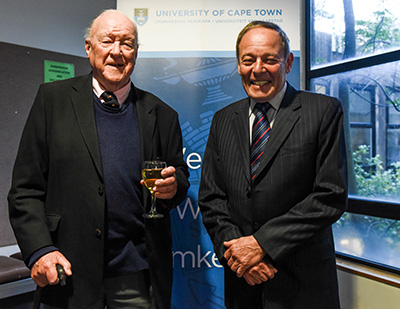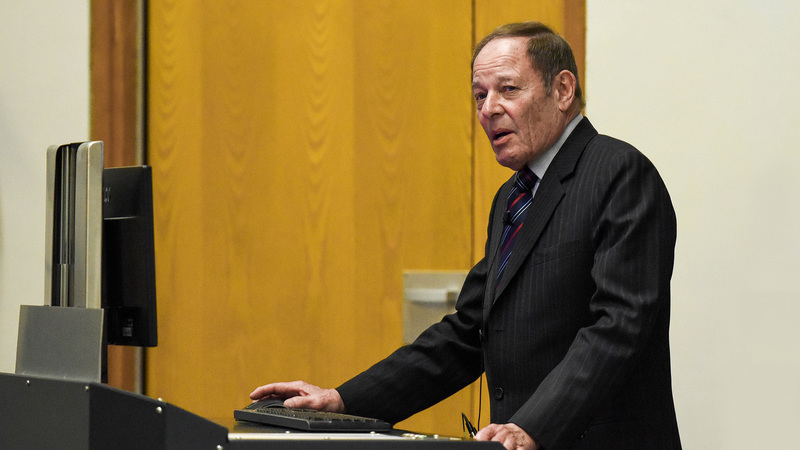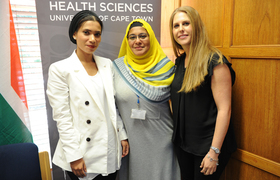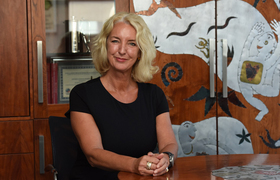Cardiovascular disease is a global problem
16 May 2018 | Story Kate-Lyn Moore. Photos Robyn Walker. Read time 5 min.In the first annual Dr Stuart John Saunders Lecture, Professor Bernard Gersh spoke to the implications of cardiovascular disease in the developing world.
Professor Gersh is a leading researcher in cardiovascular disease (CVD) with a keen interest in the epidemiology of CVD in low- and middle-income countries. He is a professor of medicine at the Mayo Clinic College of Medicine and Science in the United States and a consultant in CVD and internal medicine.
An alumnus of UCT, Gersh also has an honorary professorship in the university’s Department of Medicine.
The inaugural event, which took place on 9 May, was a fitting tribute to Saunders, a former vice-chancellor and professor of medicine at UCT.
Indeed, this new lecture series, made possible by his late wife, Anita Johanna Saunders, is intended to honour the values demonstrated during Saunders’ 15 years at the helm of the university, as vice-chancellor between 1981 and 1996, as well as the value of his contribution to the medical field.
In his opening, Gersh praised Saunders “not just for what he has done for the faculty of medicine, but his principles and values and the courage he showed during a very turbulent time at the University of Cape Town”.

The global burden of cardiovascular disease
Gersh’s lecture highlighted the global epidemic of CVDs, and focused especially on its increased prevalence in low- and middle-income countries.
Citing statistics from the World Health Organization (WHO) by way of example, he noted that of the 53 million deaths that occurred globally in 2010, 15.1 million were cardiovascular and circulatory.
But CVD in low- and middle-income countries accounted for 80% of this. Moreover, incidents of cardiovascular disease tend to occur at a younger age in these countries, impacting their workforce significantly.
Gersh analysed the potential consequences that such global rates of CVD might have for high-income countries, noting how risk factors behave differently to those in low-income settings.
He recounted how in a study of roughly 60 000 patients with risk factors for cardiovascular disease, those who were more educated, and situated in high-income countries, were less likely to develop disease in more than one vascular bed. But the study showed that a more educated person in a low- or middle-income country was far more likely to develop extensive disease involving more than one vascular bed.
“I’ve spent some time in Kenya, and they have a Swahili phrase called Wabenzi. A Wabenzi is ‘he who drives a Mercedes Benz’, and if you go into the hospitals, those are the people that are getting the heart attacks … it’s the new, empowered middle class … and that’s what’s happening right now in South Africa.”
The global implications of CVD
Gersh asked why CVD remains so low on the global health agenda even though it remains one of the leading causes of death – surpassing deaths due to malaria, HIV or AIDS, and tuberculosis.
He argued that it is in the interests of wealthy nations, and the international community at large, to care for the world’s less healthy.
“President Trump has expressed a complete lack of interest in Africa, and in aid to Africa,” he said, before offering up the following counter-argument: “The United States is already invested heavily in global health, invested heavily in malaria, TB, HIV and AIDS programmes.
“And if we want to protect our investment, why should we have spent all of this money, for people to die early of coronary disease?”
Finally, these countries have a moral and an ethical obligation to do this work. This is clear-cut, he said.
“There is no question that … high-income countries are going to have to play a role in the transformation of healthcare around the world and in Africa.”
 This work is licensed under a Creative Commons Attribution-NoDerivatives 4.0 International License.
This work is licensed under a Creative Commons Attribution-NoDerivatives 4.0 International License.
Please view the republishing articles page for more information.












